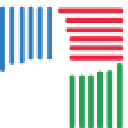Graphics Reference
In-Depth Information
12-16
A pasteboard in an application measuring
approximately 36 x 16 inches serves as a large digital
sketch pad for the development and processing of
form and ideas. (Designer: Guilherme Villar)
Typographic processes and the computer.
With the computer as a major design tool,
designers often employ hybrid problem-
solving methods. Some begin with hand-
drawn sketches and proceed to the computer
to refine and produce the final designs.
Others scan rough sketches and import them
as templates into chosen applications. In
a reciprocal process, Swiss designer Jean-
Benoît Lévy often begins with hand sketches,
redraws them on a computer, prints them
out, applies changes and color by hand, and
returns to the computer once again. Designer
Guilherme Villar creates digital pasteboards,
often containing hundreds of elements that
are combined and manipulated in search
of problem solutions (Fig.
12-16
). It is not
unusual for designers to begin the problem-
solving process by going directly to the
computer and developing ideas by means
of digital sketches and permutations. All
approaches are valid as long as the process
delivers an effective and creative solution.
Each designer is faced with embracing a
unique relationship with the computer and
all other methods, tools, and new techniques
that emerge.
When using a computer as a design tool,
file management becomes an essential part
of the design process and a design problem
in and of itself. Diligently saving each
permutation as its own file for possible future
reference or using a revision control system
such as Git are strategies for cataloging every
step of the process. Another major challenge
facing designers is how to adequately archive
digital files for future reference and, as
appropriate, for posterity.









































































































































































































































































































































































































































































































































